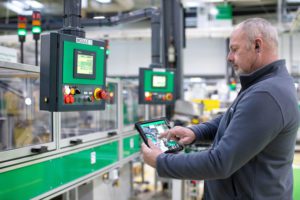Smart manufacturing is all about leveraging the collective benefit of advanced technologies to optimize operations and gain competitive advantage. Smart infrastructures within plants enable a more efficient manufacturing process allowing for faster responses to dynamic marketplace demands. A core component within the smart manufacturing facility is the smart machine. This is why OEM machine builders now find themselves at the heart of the industrial digitization revolution. The smart machines they build are the pillars of smart manufacturing.
Core to the smart machine is the smart controller. To a design engineer, “smart” means a controller built not only to control a process, but one that is also capable of communicating and linking to an IT layer. This linkage allows for the interpretation of data that can signal dynamic changes in machine workload demand, material and resource availability, and, when considered in aggregate, the overall plant capacity. The link to the data provides the transparency needed to allow users to make the right decision and to control the process in a way that ensures the highest return on factory assets.
Smart controllers within the smart machine allow it to be connectible, flexible, secure, scalable and ready to be monitored. Combined with software analytics, smart controllers enable the smart machine to react in a proactive way to changes that may happen in the future. Such capabilities allow the factory to optimize the output, to make better decisions that help to maximize profit.
Smart controller benefits include convergence of logic and motion
New developments in the area of smart controllers now provide combinations of functionalities that machine builders require to help address end user digitization challenges. For instance, smart controllers that simultaneously provide both logic and motion control.
This convergence of a logic driven machine and a more motion-oriented machine with high precision capabilities enhances both machine development and field performance through ease of programming, higher levels of connectivity, flexibility, scalability and conformity to new IIoT requirements in the areas of cybersecurity and data management.
For instance, in traditional controller (PLC) environments, when an interaction between the PLC and a solution in the cloud is required (as is the case with data monitoring, or remote maintenance tools), a gateway is required. If many links between PLCs and the cloud are required, all of these gateways need to be managed and they represent an additional degree of separation between the PLC and the data. Modern smart controllers don’t require such gateways as they offer natively lightweight data format JSON and cloud protocols MQTTs or HTTPs. With embedded encryption protocols like TLS they link directly to the cloud in a cybersecure manner. Supplementary software tool advisors can convert the data required from the machine, into easily interpreted dashboards.
Smart controllers as part of a larger collaborative ecosystem
Within the Schneider Electric framework, smart controllers, are embedded into an overall architecture called EcoStruxure Machine. EcoStruxure is an IIoT-ready platform, and, at the same time, a philosophy for embracing openness and collaboration with 3rd party devices and partner software. Such open frameworks that link common technologies make it easy for OEMs and end users to digitize mixed vendor shop environments.
As a result, rapid investment paybacks can be achieved through the deployment of digitized solutions (like smart controllers) because OEMs and users do not have to start from scratch. The pre-built architecture which links smart devices to edge control and software, analytics and services, allows for gradual evolution into more digitized environments. Such an architecture makes it easier to generate some quick wins that can be built upon and that can help to more clearly define future digitization priorities.
Smart manufacturing cannot be achieved without mastering the ability to orchestrate both existing and new technologies. The data which smart machines gather and link to the cloud will not convert to useful, actionable information without a logical architectural foundation. Linking technologies together in an open but cybersecure framework allows for management of data in an optimum way so that the right decisions can be taken to grow plant profitability.
To learn more about how new smart controllers like the Modicon M262 can facilitate digitization business benefits, visit https://www.schneider-electric.com/en/work/campaign/smart-machines/digital.jsp



